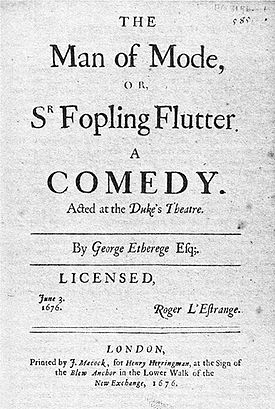
The Man of Mode
Encyclopedia

Restoration comedy
Restoration comedy refers to English comedies written and performed in the Restoration period from 1660 to 1710. After public stage performances had been banned for 18 years by the Puritan regime, the re-opening of the theatres in 1660 signalled a renaissance of English drama...
by George Etherege
George Etherege
Sir George Etherege was an English dramatist. He wrote the plays The Comical Revenge or, Love in a Tub in 1664, She Would if She Could in 1668, and The Man of Mode or, Sir Fopling Flutter in 1676.-Early life:George Etherege was born in Maidenhead, Berkshire, around 1635, to George Etherege and...
, written in 1676 and first performed March 2 of the same year. Gibbons argues that the play "offers the comedy of manners
Comedy of manners
The comedy of manners is a genre of play/television/film which satirizes the manners and affectations of a social class, often represented by stock characters, such as the miles gloriosus in ancient times, the fop and the rake during the Restoration, or an old person pretending to be young...
in its most concentrated form". Despite the subtitle, the fop
Fop
Fop became a pejorative term for a foolish man over-concerned with his appearance and clothes in 17th century England. Some of the very many similar alternative terms are: "coxcomb", fribble, "popinjay" , fashion-monger, and "ninny"...
Sir Fopling is only a marginal character; the rake
Rake (character)
A rake, short for rakehell, is a historic term applied to a man who is habituated to immoral conduct, frequently a heartless womanizer. Often a rake was a man who wasted his fortune on gambling, wine, women and song, incurring lavish debts in the process...
Dorimant is the protagonist
Protagonist
A protagonist is the main character of a literary, theatrical, cinematic, or musical narrative, around whom the events of the narrative's plot revolve and with whom the audience is intended to most identify...
.
The character of Dorimant may have been based on John Wilmot, 2nd Earl of Rochester
John Wilmot, 2nd Earl of Rochester
John Wilmot, 2nd Earl of Rochester , styled Viscount Wilmot between 1652 and 1658, was an English Libertine poet, a friend of King Charles II, and the writer of much satirical and bawdy poetry. He was the toast of the Restoration court and a patron of the arts...
, though there is no concrete evidence of this. The part was first played by Thomas Betterton
Thomas Betterton
Thomas Patrick Betterton , English actor, son of an under-cook to King Charles I, was born in London.-Apprentice and actor:...
. Sir Fopling, the flamboyant flop of the hour, by William Smith. Freshly returned from being "cultured" in Paris, Fopling attempts to emulate the love 'em and leave 'em style of Dorimant. Meanwhile Dorimant has plans to use Fopling in a scheme to lose his current lover Miss Loveit in order to seek out a new conquest.
In 2007, the National Theatre produced a modern dress
Modern dress
Modern dress is a term used in theatre and film to refer to productions of plays from the past in which the setting is updated to the present day , but the text is left relatively unchanged. For example, Baz Luhrmann's film Romeo and Juliet uses a relatively unaltered text of Shakespeare's play but...
production of the play, starring Tom Hardy
Tom Hardy
Edward Thomas "Tom" Hardy is an English actor. He is best known for playing the title character in the 2008 British film Bronson, the character of Eames in Inception, and the villain Praetor Shinzon in Star Trek Nemesis...
as Dorimant. Rory Kinnear
Rory Kinnear
Rory Kinnear is an award-winning English actor who has worked with the Royal Shakespeare Company and the Royal National Theatre.-Early life:...
received a Laurence Olivier Award for his performance as Fopling.
External links
- John Dennis, A Defense of Sir Fopling Flutter (1722).

